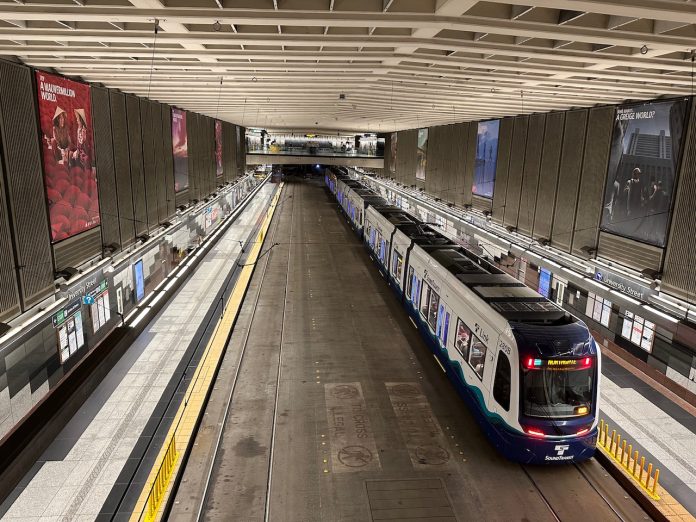Splitting up the four-line, 116-mile system into smaller segments allows greater frequencies with fewer traincars.
Link is in trouble. Service planning estimates widely missed the mark on how many trains that Sound Transit would need to run the Link system as it is expanded into the 2030s and 2040s. Agency planners now believe that they will need at least 90 more light rail vehicles (LRVs) to reach planned six-minute frequencies on each line. That would also necessitate greatly upsizing maintenance and storage facilities or building a new one. In turn, this would mean many billions of dollars in extra system costs — somewhere on order of $3 billion or $4 billion — to deliver Sound Transit 3 (ST3) at promised frequencies.
Right-sizing Link, however, could deliver huge savings and actually deploy service where there is demand and logical connections.
Link’s dirty secret is that it’s being heavily overbuilt
Sound Transit is planning a 116-mile light rail network to far-flung suburbs with just four lines. For years, the idea has been that a vast Link network would move suburban commuters into central business districts on weekdays while acting as a daily metro system for urban dwellers. However, the problem is that Link is being designed to do too many things and none of them well.
For many segments, Link won’t be terribly time competitive with driving, even during peak weekday commute periods. Sound Transit has intentionally tried to make up for this by spacing suburban station further apart than in denser urban areas. But those distances are not sufficient enough to benefit much from higher operating speeds, which are still fairly constrained since light rail technology isn’t designed to maintain them well. Maximum speed of light rail technology is usually limited to below-freeway speeds whereas modern heavy rail and interurban rail technologies can better maintain and achieve higher operating speeds. Sounder commuter rail, for instance, operates much faster than Link, reaching track speed limits of 79 miles per hour.
Another issue is that many of the planned and existing suburban stations have little density around them now and will not become the kinds of expansive transit-oriented districts that people dream of, even with regulatory land use reforms. Ridership estimates for these stations reflect that with paltry numbers often in the low single-digit thousands.
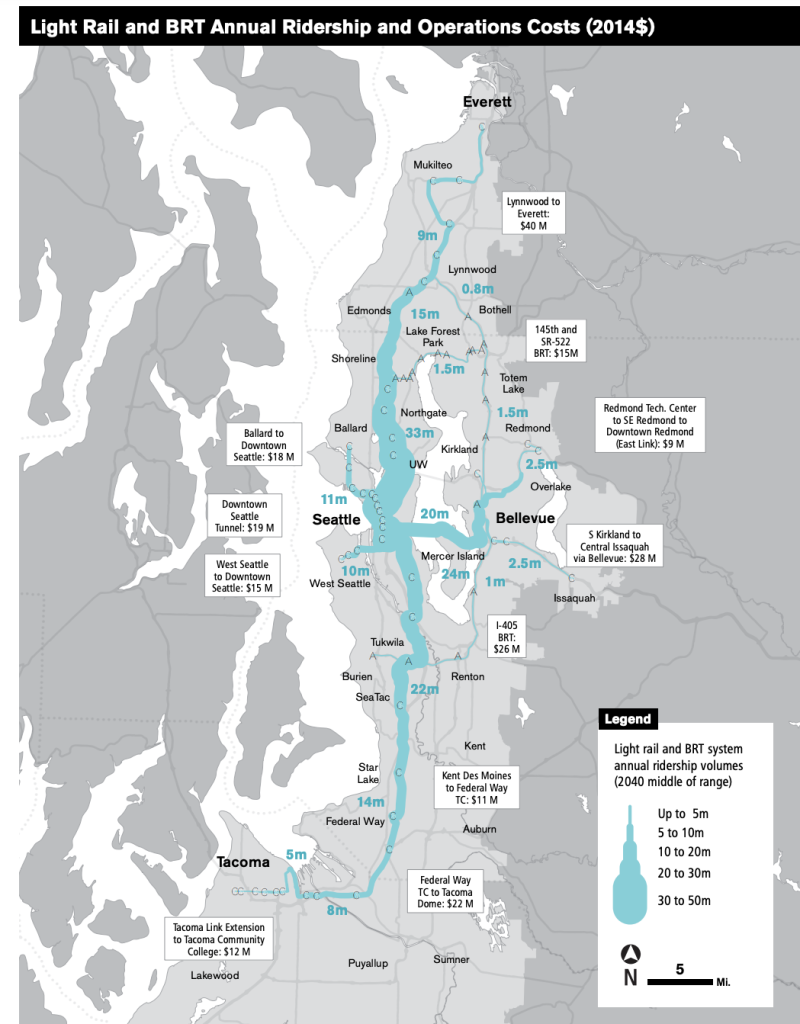
Take the South Kirkland-Issaquah Link and Everett Link extensions. Ridership on the two corridors is expected to be between 1,276 and 2,760 riders per mile on the high end. Ballard Link by comparison is expected to deliver over 31,100 riders per mile. Stations on the deeper suburban extensions are going to be more like a leaky faucet than the gushing main line of riders that denser urban stations represent.
For denser urban areas like Seattle, the station density is understandably higher and Link operates faster over in-city distances than bus alternatives making it a desirable mode for regular city travel. But because Link is designed as a hybrid also serving suburban contexts, the average frequency is too low for Link to act as a proper urban metro train. Ten-minute daytime frequencies are similar to what a workhorse bus offers. Urban rail should be more frequent.
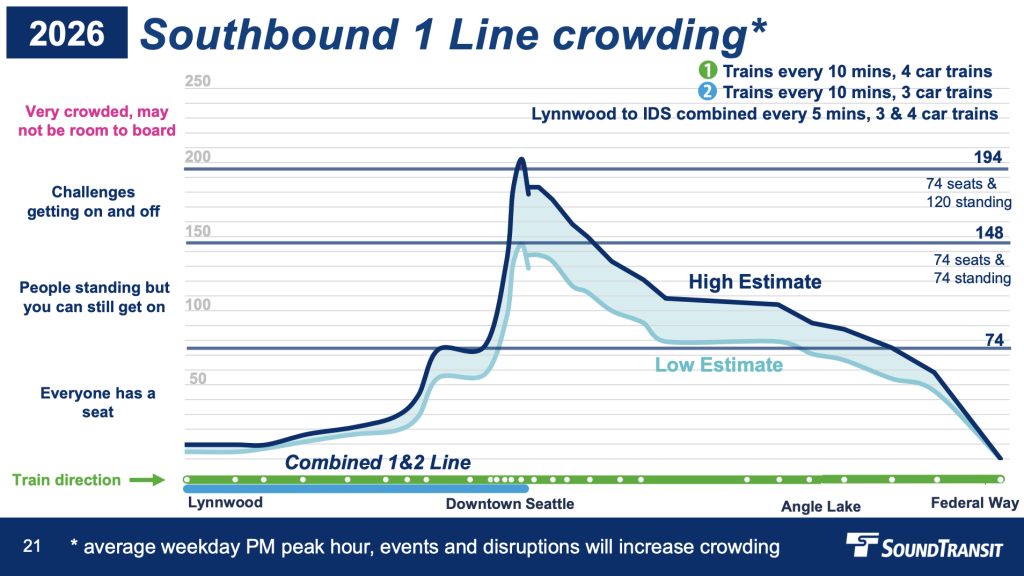
On top of this, Link’s confused nature as an urban-metro-commuter-rail hybrid means that its infrastructure is being built close to the standards of an urban metro but using low-capacity light rail technology. And that’s coming at considerably higher costs than if Sound Transit recognized this and simply bifurcated the regional investments in rail transportation with light metro in the city and proper regional rail in the suburbs.
With all this in mind, perhaps it’s time for Sound Transit to greatly rethink the Link network because not all segments of the system need six-minute frequency with four-car trains, especially if trains will mostly run empty in the deeper suburbs. That’s an oversupply and mismatch of service in much of the system. Instead, the operating plan could be adjusted to more closely match demand and local characteristics.
A concept to right-size the ST3 Link service plan
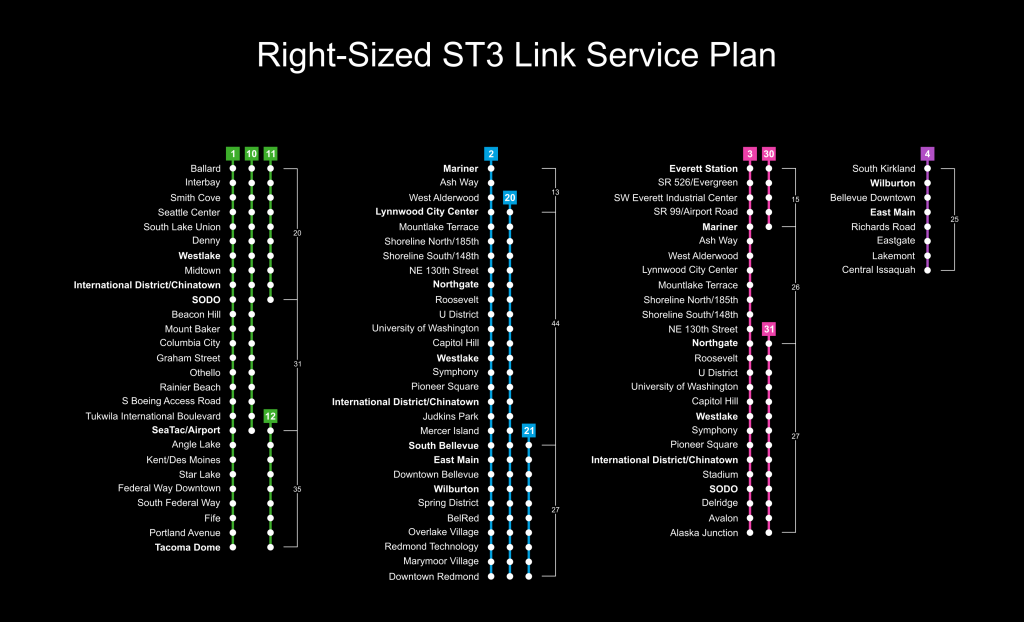
Building upon the work Sound Transit has done, the system could be broken into 11 lines across four defined corridors. This would allow the agency to invest service where there is a real need.
In the heart of the system, Sound Transit could provide combined frequency through the downtown tunnels every three minutes. This would offer a big service boost to Ballard, Uptown, U District, Capitol Hill, and Downtown Seattle where ridership is highest. To do this, the Ballard-SoDo segment would be served by three lines each with four to eight trips per hour. One of those lines would run as far as SoDo (11 Line) while the other two would be extended to the airport (10 Line) and Tacoma (1 Line). That has the knock-on benefit of the Rainier Valley getting service every five minutes — an improvement from today and over Sound Transit’s ST3 operating plan. Between International District/Chinatown and Northgate, service would be blended with four lines also offering high frequencies and access to West Seattle, Snohomish County, and the Eastside.
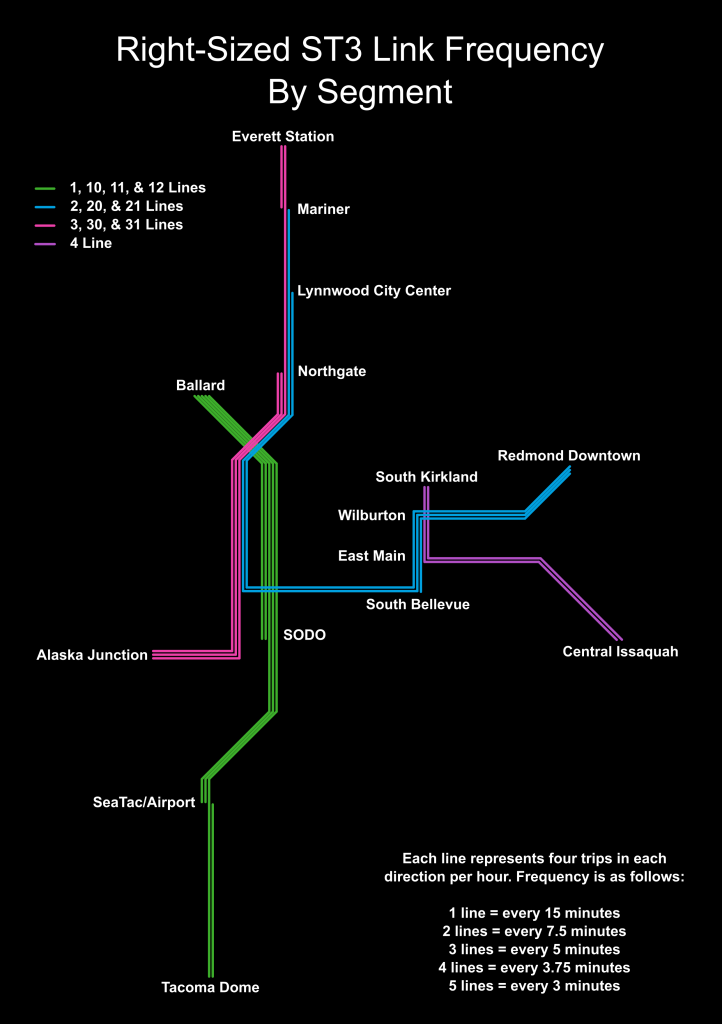
The suburbs also get in on the action with high frequencies. For instance, riders from Everett could make local trips or regional ones every 7.5 minutes. Half of the trips would continue all the way to West Seattle and the other half would terminate at Mariner. Riders wanting to continue a journey could transfer at Mariner to a train bound for Redmond via Seattle (2 Line). The wait time for the connecting train would be minor, but may be the regional train the rider wanted anyway. The train between Everett Station and Mariner would be a shorter with two cars, a reflection of how local service could be right-sized to demand.
As another example, riders from Tacoma and Federal Way could have very frequent access to their main destination: the airport. The 12 Line would be overlaid on the 1 Line to offer combined frequency to the airport every 7.5 minutes. That’s far and away more frequent than bus options today, but half of the trains would continue onward to Seattle to still provide a frequent regional connection without a transfer. Riders could take a 12 Line train to the airport and then transfer to the 11 Line to continue toward Seattle with a minimal time penalty.
| Trips Per Hour | 2-Car Train Capacity | 4-Car Train Capacity |
|---|---|---|
| 4 | 1,584 riders per direction | 3,168 riders per direction |
| 8 | 3,168 riders per direction | 6,336 riders per direction |
As for other segments, West Seattle, South Bellevue to Redmond, and Northgate to Lynnwood could benefit from five-minute frequencies while Mariner to Lynnwood, Kirkland to Issaquah, and cross-lake service would be closer to every 7.5 minutes.
The service concept would apply the vast majority of the day, allowing the agency to provide consistent service throughout the day in an era when transit is less peaky and more spread throughout the day. Outside of regular daytime hours, Sound Transit could trim the Link system back to just the 1, 2, 3, and 4 Lines that run the whole length of the corridors.
While this service concept is in many ways more frequent than Sound Transit’s base operating plan, it would actually require many fewer vehicles to do it. On the low end, only 357 LRVs would be required, including spares, to operate the system under perfect conditions. A more conservative estimate to allow for extra gap and recovery trains would require 446 LRVs. Sound Transit’s current operating plan, which had originally anticipated needing 460 LRVs, now requires 550 LRVs. In other words, this service concept could save the agency billions of dollars and avoid unnecessary investments in infrastructure and equipment — which likely has years of delay involved.
The main challenges with this service concept would be maintaining consistent operations — a challenge that Sound Transit already routinely fails at with one line — and building in turn-back and on-line temporary storage infrastructure. This will require a lot of targeted infrastructure improvements — particularly near key stations — as well as enhanced operating strategies and know-how, but it could be achievable at a significantly lower cost and faster than Sound Transit’s alternative.
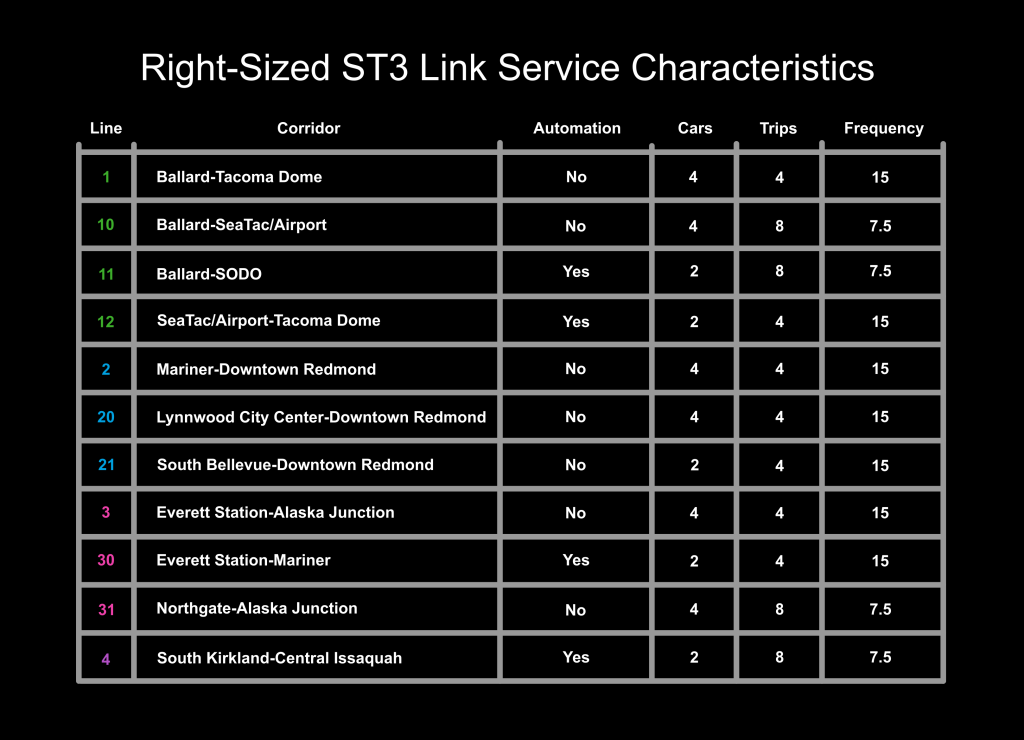
From a rider standpoint, the main downside of this concept is that service over the longest distances would be lower during daytime hours and some trips may be accomplished with an extra transfer or two. However, the overall frequencies across segments could more than make up for this. Combined frequencies over all segments would still be about every 7.5 minutes or better — better than today’s service levels.
As part of this concept, some segments of Link could be fully automated. Those include Ballard-SoDo (11 Line), SeaTac/Airport-Tacoma Dome (12 Line), Everett Station-Mariner (30 Line), and South Kirkland-Central Issaquah (4 Line) since they won’t have conflicting at-grade crossing segments. Automating allows for more consistent service operations and lower operational costs since trains don’t have to be operated by a driver.
Sound Transit service planners have tried to eschew turn-backs and worry about uneven loads on platforms. But the overall of level of frequency of this concept and right system improvements could more than ameliorate those technical concerns.
Right-sizing Link operations is the best alternative in absence of political will to spend billions of additional dollars and further delay a transit expansion program already well over-budget and delayed.
This right-sizing concept is not the first in its genre. Eliza Shaner outlined a seven-line Link system in 2016 on Seattle Transit Blog, which is also worth a read.
Stephen is a professional urban planner in Puget Sound with a passion for sustainable, livable, and diverse cities. He is especially interested in how policies, regulations, and programs can promote positive outcomes for communities. With stints in great cities like Bellingham and Cork, Stephen currently lives in Seattle. He primarily covers land use and transportation issues and has been with The Urbanist since 2014.

